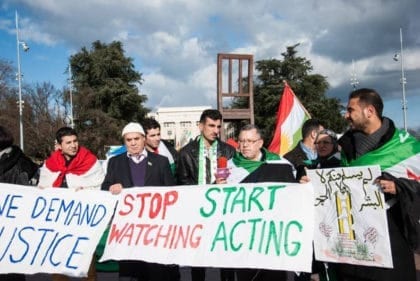
Introduction
Syria has not been immune from the wave of pro-democracy agitation that has swept the Arab world since the end of 2010. Inspired by the mass protests that had taken place in Tunisia, Libya and Egypt, major protest demonstrations took place throughout Syria from January 2011 and gathered momentum in mid-March, meeting brutal repression from the authorities.
Syrians, having lived under the oppressive rule of Hafez al-Assad, had now dared to take to the streets to protest against the regime of Bashar al-Assad, who in 2000 had taken over from his father, with promises to introduce reforms and an opening of the political atmosphere.
Despite the ‘Damascus Spring’, as this opening during the first six months of al-Assad the son was called, Syrian authorities closed the newly created civil society groups and detained political activists. In addition, the role of the infamous security services was left intact. In contrast to what many Syrians had expected from the young al-Assad, they were confronted with the same power structure his father had used to oppress the population.
While Bashar al-Assad liberalised the economy somewhat, the state’s dominance of the economy was maintained, and private entrepreneurs depended for their success on close – and often financially corrupt – associations with key figures in the regime or in al-Assad’s family. Only the small, albeit growing, middle class prospered.
For the most part of the population, the situation remained as difficult as it had always been. Unemployment was estimated at 30 percent, and low salaries meant that corruption was rife. This, together with disappointment over the lack of actual reforms, led Syrians to take to the streets.
Demonstrations that spread all over the country were brutally oppressed by Syrian security forces, as the regime soon called the demonstrators “terrorists”. As a result of the violent response to the peaceful protests, the protesters were hardened in their opposition against the regime and began calling for the regime’s overthrow.
Once officers defected from the Syrian army, refusing to fight against their own people, and numerous opposition factions were formed to fight against the regime, the conflict was deemed a civil war.
A civil war which eventually led millions of Syrians displaced, with millions of others fleeing their country.
A civil war which had evolved into a major crisis which involved outside players, either in support of the opposition (among which Saudi Arabia, Qatar) or on the side of the regime (among which Iran, Hezbollah, Russia). A ‘proxy war’ was born, with these outside forces all trying to defend their own interests. Meanwhile, Islamic extremist groups, including Islamic State, had used the chaos in Syria to strengthen their grip on parts of the country.
The European Union, where most Syrians had found refuge, and the United States, with its own interests, also found themselves involved in the crisis. On the other hand, China has been persistently supporting the al-Assad regime since the start.
And finally, a civil war which, despite numerous attempts to halt the violence and come with a diplomatic solution, has led to immense suffering among the Syrian population and a country in ruins.
——
Fanack presents this file on the Syrian Crisis, describing the crisis and its several phases in parts.
In part 1, the start of the Syrian revolution and the escalation towards conflict are described.
In part 2, read about the Islamisation of the Syrian revolution and how the al-Assad regime benefited from differences and battles between the several armed opposition groups.
Part 3 analyses how the Syrian regime dealt with both its supporters and its opponents throughout the Syrian Crisis and how the balance tilted in favour of the regime.
In part 4, you can read how the relationship of the Syrian regime with outside powers developed during the Syrian Crisis, and how the regime dealt with these players in order to stay in power. For example, the regime attempted to present itself as indispensable for the future of Syria, while it was accused of using the threat of terrorism and Syrian refugees against the West.
Part 5 analyses how the relationship of the Assad regime with Arab regimes changed after the outbreak of the revolution in Syria. This relationship was not only influenced by Arab isolation and Gulf support for the Syrian opposition, but also by the Iranian and Russian presence in Syria. In fact, Russia and Iran have been instrumental in shaping Syrian-Arab relations. The Syrian regime has benefitted from this in several ways, leading to the return of Syria to the Arab fold, which has further enabled its survival.
As the Syrian Revolution progressed, non-violent opposition activists had to work under huge pressure, putting their lives at risk. Eventually, they were excluded from any role in a solution to the Syrian Crisis, whether they fled Syria or not. In part 6, Fanack explains who these revolutionary activists were and how they met their fate.
Stay tuned for more….
Further Reading
Below are the publications by acclaimed journalists and academics concerning the Syrian crisis section of this country file:









